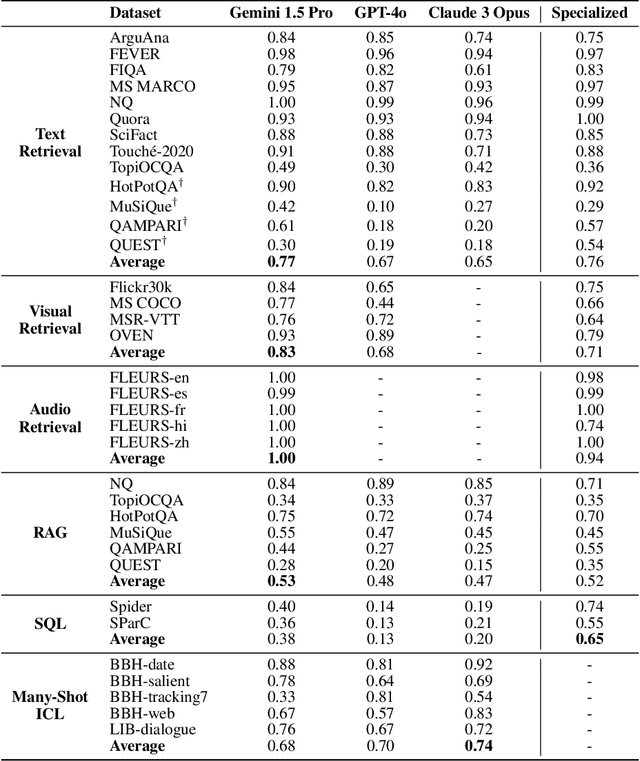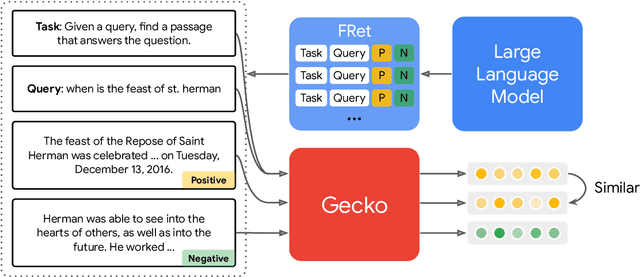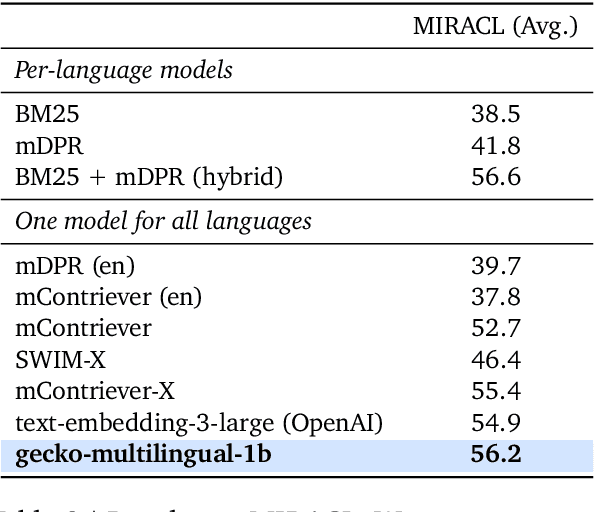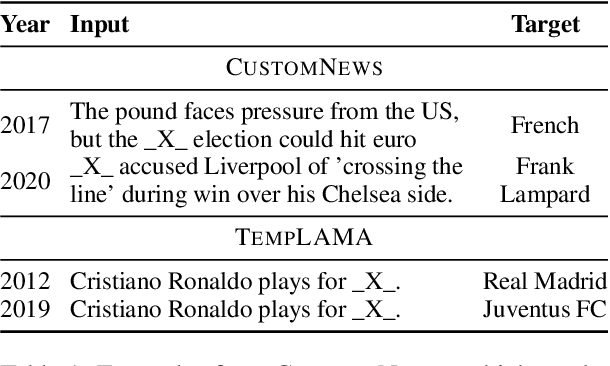Jeremy R. Cole
Can Long-Context Language Models Subsume Retrieval, RAG, SQL, and More?
Jun 19, 2024



Abstract:Long-context language models (LCLMs) have the potential to revolutionize our approach to tasks traditionally reliant on external tools like retrieval systems or databases. Leveraging LCLMs' ability to natively ingest and process entire corpora of information offers numerous advantages. It enhances user-friendliness by eliminating the need for specialized knowledge of tools, provides robust end-to-end modeling that minimizes cascading errors in complex pipelines, and allows for the application of sophisticated prompting techniques across the entire system. To assess this paradigm shift, we introduce LOFT, a benchmark of real-world tasks requiring context up to millions of tokens designed to evaluate LCLMs' performance on in-context retrieval and reasoning. Our findings reveal LCLMs' surprising ability to rival state-of-the-art retrieval and RAG systems, despite never having been explicitly trained for these tasks. However, LCLMs still face challenges in areas like compositional reasoning that are required in SQL-like tasks. Notably, prompting strategies significantly influence performance, emphasizing the need for continued research as context lengths grow. Overall, LOFT provides a rigorous testing ground for LCLMs, showcasing their potential to supplant existing paradigms and tackle novel tasks as model capabilities scale.
Gecko: Versatile Text Embeddings Distilled from Large Language Models
Mar 29, 2024



Abstract:We present Gecko, a compact and versatile text embedding model. Gecko achieves strong retrieval performance by leveraging a key idea: distilling knowledge from large language models (LLMs) into a retriever. Our two-step distillation process begins with generating diverse, synthetic paired data using an LLM. Next, we further refine the data quality by retrieving a set of candidate passages for each query, and relabeling the positive and hard negative passages using the same LLM. The effectiveness of our approach is demonstrated by the compactness of the Gecko. On the Massive Text Embedding Benchmark (MTEB), Gecko with 256 embedding dimensions outperforms all existing entries with 768 embedding size. Gecko with 768 embedding dimensions achieves an average score of 66.31, competing with 7x larger models and 5x higher dimensional embeddings.
Selectively Answering Ambiguous Questions
May 24, 2023Abstract:Trustworthy language models should abstain from answering questions when they do not know the answer. However, the answer to a question can be unknown for a variety of reasons. Prior research has focused on the case in which the question is clear and the answer is unambiguous but possibly unknown. However, the answer to a question can also be unclear due to uncertainty of the questioner's intent or context. We investigate question answering from this perspective, focusing on answering a subset of questions with a high degree of accuracy, from a set of questions in which many are inherently ambiguous. In this setting, we find that the most reliable approach to calibration involves quantifying repetition within a set of sampled model outputs, rather than the model's likelihood or self-verification as used in prior work. % We find this to be the case across different types of uncertainty, varying model scales and both with or without instruction tuning. Our results suggest that sampling-based confidence scores help calibrate answers to relatively unambiguous questions, with more dramatic improvements on ambiguous questions.
NAIL: Lexical Retrieval Indices with Efficient Non-Autoregressive Decoders
May 23, 2023Abstract:Neural document rerankers are extremely effective in terms of accuracy. However, the best models require dedicated hardware for serving, which is costly and often not feasible. To avoid this serving-time requirement, we present a method of capturing up to 86% of the gains of a Transformer cross-attention model with a lexicalized scoring function that only requires 10-6% of the Transformer's FLOPs per document and can be served using commodity CPUs. When combined with a BM25 retriever, this approach matches the quality of a state-of-the art dual encoder retriever, that still requires an accelerator for query encoding. We introduce NAIL (Non-Autoregressive Indexing with Language models) as a model architecture that is compatible with recent encoder-decoder and decoder-only large language models, such as T5, GPT-3 and PaLM. This model architecture can leverage existing pre-trained checkpoints and can be fine-tuned for efficiently constructing document representations that do not require neural processing of queries.
Salient Span Masking for Temporal Understanding
Mar 22, 2023



Abstract:Salient Span Masking (SSM) has shown itself to be an effective strategy to improve closed-book question answering performance. SSM extends general masked language model pretraining by creating additional unsupervised training sentences that mask a single entity or date span, thus oversampling factual information. Despite the success of this paradigm, the span types and sampling strategies are relatively arbitrary and not widely studied for other tasks. Thus, we investigate SSM from the perspective of temporal tasks, where learning a good representation of various temporal expressions is important. To that end, we introduce Temporal Span Masking (TSM) intermediate training. First, we find that SSM alone improves the downstream performance on three temporal tasks by an avg. +5.8 points. Further, we are able to achieve additional improvements (avg. +0.29 points) by adding the TSM task. These comprise the new best reported results on the targeted tasks. Our analysis suggests that the effectiveness of SSM stems from the sentences chosen in the training data rather than the mask choice: sentences with entities frequently also contain temporal expressions. Nonetheless, the additional targeted spans of TSM can still improve performance, especially in a zero-shot context.
DIFFQG: Generating Questions to Summarize Factual Changes
Mar 01, 2023Abstract:Identifying the difference between two versions of the same article is useful to update knowledge bases and to understand how articles evolve. Paired texts occur naturally in diverse situations: reporters write similar news stories and maintainers of authoritative websites must keep their information up to date. We propose representing factual changes between paired documents as question-answer pairs, where the answer to the same question differs between two versions. We find that question-answer pairs can flexibly and concisely capture the updated contents. Provided with paired documents, annotators identify questions that are answered by one passage but answered differently or cannot be answered by the other. We release DIFFQG which consists of 759 QA pairs and 1153 examples of paired passages with no factual change. These questions are intended to be both unambiguous and information-seeking and involve complex edits, pushing beyond the capabilities of current question generation and factual change detection systems. Our dataset summarizes the changes between two versions of the document as questions and answers, studying automatic update summarization in a novel way.
Do ever larger octopi still amplify reporting biases? Evidence from judgments of typical colour
Sep 26, 2022



Abstract:Language models (LMs) trained on raw texts have no direct access to the physical world. Gordon and Van Durme (2013) point out that LMs can thus suffer from reporting bias: texts rarely report on common facts, instead focusing on the unusual aspects of a situation. If LMs are only trained on text corpora and naively memorise local co-occurrence statistics, they thus naturally would learn a biased view of the physical world. While prior studies have repeatedly verified that LMs of smaller scales (e.g., RoBERTa, GPT-2) amplify reporting bias, it remains unknown whether such trends continue when models are scaled up. We investigate reporting bias from the perspective of colour in larger language models (LLMs) such as PaLM and GPT-3. Specifically, we query LLMs for the typical colour of objects, which is one simple type of perceptually grounded physical common sense. Surprisingly, we find that LLMs significantly outperform smaller LMs in determining an object's typical colour and more closely track human judgments, instead of overfitting to surface patterns stored in texts. This suggests that very large models of language alone are able to overcome certain types of reporting bias that are characterized by local co-occurrences.
WinoDict: Probing language models for in-context word acquisition
Sep 25, 2022



Abstract:We introduce a new in-context learning paradigm to measure Large Language Models' (LLMs) ability to learn novel words during inference. In particular, we rewrite Winograd-style co-reference resolution problems by replacing the key concept word with a synthetic but plausible word that the model must understand to complete the task. Solving this task requires the model to make use of the dictionary definition of the new word given in the prompt. This benchmark addresses word acquisition, one important aspect of the diachronic degradation known to afflict LLMs. As LLMs are frozen in time at the moment they are trained, they are normally unable to reflect the way language changes over time. We show that the accuracy of LLMs compared to the original Winograd tasks decreases radically in our benchmark, thus identifying a limitation of current models and providing a benchmark to measure future improvements in LLMs ability to do in-context learning.
Graph-Based Decoding for Task Oriented Semantic Parsing
Sep 09, 2021



Abstract:The dominant paradigm for semantic parsing in recent years is to formulate parsing as a sequence-to-sequence task, generating predictions with auto-regressive sequence decoders. In this work, we explore an alternative paradigm. We formulate semantic parsing as a dependency parsing task, applying graph-based decoding techniques developed for syntactic parsing. We compare various decoding techniques given the same pre-trained Transformer encoder on the TOP dataset, including settings where training data is limited or contains only partially-annotated examples. We find that our graph-based approach is competitive with sequence decoders on the standard setting, and offers significant improvements in data efficiency and settings where partially-annotated data is available.
Time-Aware Language Models as Temporal Knowledge Bases
Jun 29, 2021



Abstract:Many facts come with an expiration date, from the name of the President to the basketball team Lebron James plays for. But language models (LMs) are trained on snapshots of data collected at a specific moment in time, and this can limit their utility, especially in the closed-book setting where the pretraining corpus must contain the facts the model should memorize. We introduce a diagnostic dataset aimed at probing LMs for factual knowledge that changes over time and highlight problems with LMs at either end of the spectrum -- those trained on specific slices of temporal data, as well as those trained on a wide range of temporal data. To mitigate these problems, we propose a simple technique for jointly modeling text with its timestamp. This improves memorization of seen facts from the training time period, as well as calibration on predictions about unseen facts from future time periods. We also show that models trained with temporal context can be efficiently ``refreshed'' as new data arrives, without the need for retraining from scratch.
 Add to Chrome
Add to Chrome Add to Firefox
Add to Firefox Add to Edge
Add to Edge